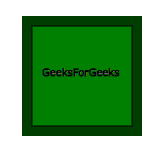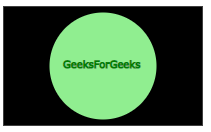SVG代表可缩放矢量图形。它可以像HTML画布一样用于制作图形和动画。
<feBlend>元素用于将两个图像或SVG片段组合为单个图形。它执行两个输入的SVG片段或图像的pixel-wise组合。
用法:
<feBlend in="" in2="" mode=""/>
属性:
- in -它标识给定过滤器原语的输入。
- in2 -标识给定过滤器原语的第二个输入。它具有与‘in’属性相同的值。
- mode -它在<feBlend>过滤器原语上定义了混合模式。如果未指定mode,则执行常规值。
范例1:
<!DOCTYPE html>
<html>
<body>
<svg width="200" height="200">
<defs>
<filter id="spotlight">
<feFlood result="floodFill"
x="0" y="0" width="100%"
height="100%" flood-color="green"
flood-opacity="1" />
<feBlend in="FillPaint"
in2="floodFill" mode="multiply" />
</filter>
</defs>
<rect x="40" y="40" width="100"
height="100" style="stroke:#000000;
fill:lightgreen;
filter:url(#spotlight);" />
<rect x="40" y="40" width="100" height="100"
style="stroke:#000000; fill:green;" />
<g fill="#FFFFFF" stroke="black" font-size="10"
font-family="Verdana">
<text x="50" y="90">GeeksForGeeks</text>
</g>
</svg>
</body>
</html>输出:

范例2:
<!DOCTYPE html>
<html>
<body>
<svg width="200" height="200">
<defs>
<filter id="Screen">
<feBlend mode="screen"
in2="BackgroundImage"
in="SourceGraphic" />
</filter>
</defs>
<rect x="1" y="1" width="198"
height="118" style="stroke:#000000;
fill:black;
filter:url(#Screen);" />
<circle cx="100" cy="60" r="55"
stroke="black" stroke-width="3"
fill="Lightgreen" />
<g fill="#FFFFFF" stroke="Green"
font-size="10" c font-family="Verdana">
<text x="60" y="62">GeeksForGeeks</text>
</g>
</svg>
</body>
</html>输出:

相关用法
- SVG <marker>用法及代码示例
- SVG <desc>用法及代码示例
- SVG <a>用法及代码示例
- SVG <clipPath>用法及代码示例
- SVG <title>用法及代码示例
- SVG <animateMotion>用法及代码示例
- SVG <animate>用法及代码示例
- SVG <g>用法及代码示例
- SVG <textPath>用法及代码示例
- SVG <tspan>用法及代码示例
- SVG <use>用法及代码示例
- SVG <symbol>用法及代码示例
- SVG <foreignObject>用法及代码示例
- SVG <hatch>用法及代码示例
- SVG <set>用法及代码示例
- SVG <feFlood>用法及代码示例
注:本文由纯净天空筛选整理自epistler_999大神的英文原创作品 SVG <feBlend> Element。非经特殊声明,原始代码版权归原作者所有,本译文未经允许或授权,请勿转载或复制。
